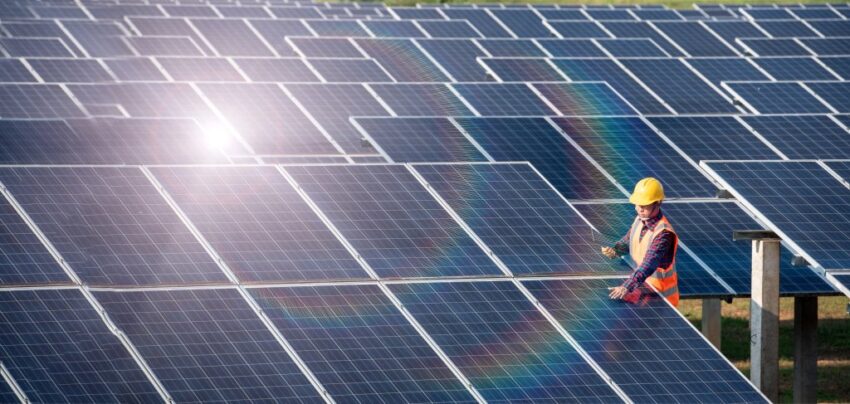(Photo by Joe Raedle/Getty Images)
The Environmental Protection Agency is weighing the termination of its $7 billion Solar For All program, a move that would strip Nevada of millions of dollars in federal funding for residential solar development.
Last year, the Nevada Clean Energy Fund — a nonprofit bank created by state legislation — was awarded a $156 million grant under the Solar for All program to finance community solar projects that would benefit low-income households.
Now that funding is jeopardized by the Trump administration’s proposal to axe the Biden-era program created under the Inflation Reduction Act, a 2022 law that dedicated nearly $370 billion to the clean energy transition.
In a statement, an EPA spokesperson said the agency is “working to ensure Congressional intent is fully implemented in accordance with the law” after the passage of Trump’s “One Big Beautiful Bill” last month.
The tax and spending bill eliminated the IRA’s $27 billion Greenhouse Gas Reduction Fund – which finances the Solar for All grant – and scrapped all unobligated money under the fund. Nevada’s Solar for All funds have already been contractually obligated, which could make terminating the states’ grant more difficult.
Solar for All is the only surviving grant under the Greenhouse Gas Reduction Fund after EPA Administrator Lee Zeldin announced the cancellation of the fund’s other two federal grants in March.
The Nevada Clean Energy Fund said it has not received a Solar for All termination notice as of Wednesday. The nonprofit is still accepting applications, and encourages anyone interested in the program to apply.
“We hear from Nevadans every day that they desperately need the relief that comes from our Nevada Solar for All program, and we have been working hard over the past year to get these funds into the hands of the households that need them,” said Kirsten Stasio, CEO of the Nevada Clean Energy Fund.
Nevada has been racing to get money out the door after funding for the program was frozen in February as the result of an executive order from President Donald Trump. The EPA unfroze those funds the following month in response to court orders.
The Nevada Clean Energy Fund selected its first project under the program last month, which would provide low-cost solar power for The Empowerment Center’s new sober living facility in Reno.
“We received a Nevada Solar for All investment that is transformational for our organization and the women we serve,” said Roxanne DeCarlo, executive director of The Empowerment Center, which helps low income and at-risk women recovering from substance abuse.
“Lower energy costs mean we can focus more resources on what matters most: helping women rebuild their lives in a safe, stable environment,” DeCarlo said.
Nevada is one of 60 grant recipients, including 49 state agencies, that could lose millions in federal funding if the program is successfully terminated.
Nevada was awarded the largest Solar for All grant per capita of any state. Nevada received the same award amount as Florida, Illinois, and Pennsylvania — states with significantly higher populations.
If terminated, the Nevada Clean Energy Fund said the state could lose high paying jobs and hundreds of millions of dollars in additional private investment.
Mark Dickson, president of Simple Power Solar, called Nevada’s Solar for All program “a critical stabilizer” for the solar industry as it navigates difficult economic headwinds.
“Our workforce of over 35 employees, along with thousands of others from dozens of other companies statewide, rely on the continued support and demand generated by this program,” Dickson said.
Nevada’s solar industry is already facing strain after Trump’s “Big Beautiful Bill” rolled back most federal support for renewable energy last month, including tax credits that fueled solar development.
Under the tax and spending bill, solar projects that start construction after July 4, 2026 will not be eligible for the 30% Clean Electricity Investment Credit — phasing out the credit six years ahead of schedule. If those projects are not in service by the end of 2027 they also won’t get the full credit. The 30% Residential Clean Energy Credit ends entirely at the end of 2025.
The loss of the residential solar credit is “already disrupting clean energy businesses,” said Steve Hamile, the CEO of Sol-Up, the company slated to install the Empowerment Center’s solar project.
“Sol-Up employs nearly 200 people, and the stability and demand from this program are important for sustaining our workforce,” Hamile said.
The early termination of solar tax credits would likely require the Nevada Clean Energy Fund to cover more solar installation costs in the state while funding less projects, said Greg Zegas, the managing director of investments at the Nevada Clean Energy Fund.
Nevada’s Clean Energy Fund already lost a $20 million grant from the EPA in May that would have funded the construction of critical water and energy infrastructure on the Walker River Paiute Tribe reservation in Northern Nevada.
Solar for All funds were expected to lower energy costs by at least 20% for more than 50,000 low-income and disadvantaged households in Nevada by 2029.
Without the program, low-income households will be left with fewer options to address rising energy costs, said Beth Dunning, the director of community development at Nevada Rural Housing.
“Nevada Solar for All will lower electricity bills for many rural families who otherwise would be unable to access these savings and increase energy reliability in rural and remote communities that face frequent power outages,” Dunning said.
Click this link for the original source of this article.
Author: Jeniffer Solis
This content is courtesy of, and owned and copyrighted by, https://www.nevadacurrent.com and its author. This content is made available by use of the public RSS feed offered by the host site and is used for educational purposes only. If you are the author or represent the host site and would like this content removed now and in the future, please contact USSANews.com using the email address in the Contact page found in the website menu.








